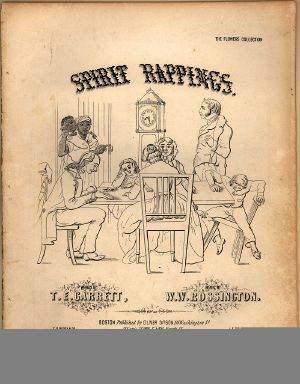Difference between revisions of "Séance" - New World Encyclopedia
(Started) |
({{Contracted}}) |
||
| Line 1: | Line 1: | ||
| − | {{Started}}{{Claimed}} | + | {{Started}}{{Claimed}}{{Contracted}} |
[[Category:Politics and social sciences]] | [[Category:Politics and social sciences]] | ||
[[Category:Communication]] | [[Category:Communication]] | ||
Revision as of 15:18, 26 February 2007
A séance (pronounced: [seɪɑ:ns]) is, on its most basic level, an attempt to communicate with the dead. The séance, or sitting, is led by a person known as a medium who will usually go into a trance that theoretically allows the dead to communicate through him or her.
The word séance comes from the French word for 'seat', 'session', from Old French seoir, 'to sit.' In English, the word came to be used specifically for a meeting of people to receive spiritualistic messages (a sense first recorded in English in 1845). In French, it is much more general: one can say une séance de cinéma.
Séances were conducted in dark or semi-dark rooms with participants seated around a table. Some say this is to help the medium use tricks to fool the participants. Sometimes the table would lean and tilt, participants (sitters) might feel a cold breeze on their faces, items could materialize apparently out of thin air and musical instruments might play mysteriously. During the course of the séance, the medium would speak under the apparent control of a spirit, relaying messages from the dearly departed. Other methods of spirit communication included automatic writing, writing on sealed slates, writing with planchettes (similar to the Ouija board), impressing images onto photographic plates which had been kept in sealed enclosures, and painted images which gradually appeared upon previously blank canvas.
Belief in the ability to communicate with the dead is part of, although not exclusive to, a religious movement called Spiritualism, which flourished from the 1840s until the 1920s and still exists in various forms today. Skeptics generally consider séances to be scams, or at least a form of pious fraud. M. Lamar Keene once practiced scam séances, but revealed the fraud in his book, The Psychic Mafia (Randi 1995:135).
Channelling
Channelling is a common element of a séance. This is said to be the process by which the medium allows a spirit limited use of their physical body to communicate with the sitters present. This is distinct from the concept of 'possession', which is considered to be the complete, non-consensual takeover of a living being by a spirit or demon, and is usually detrimental to the 'victim'. Channelling, on the other hand, is assumed by believers to offer opportunities for more positive and mutually respectful interaction between the living medium and the spirit. The most commonly-reported physical manifestations of channelling are an unusual vocal pattern or uncharacteristic physical behaviours by the medium. Therefore, channelling is quite easily faked, and is considered by skeptics to be a rather basic 'trick'; although for participants, hearing a message believed to be from a dead loved one can be an emotionally powerful experience.
Séances in media
- Séance on a Wet Afternoon (1965) - Kim Stanley plays a medium who tries to convince her disbelieving husband to commit a crime.
- Ghost - Character Oda Mae Brown (played by Whoopi Goldberg) was a con artist conducting fake séances for money, but then discovers she really can talk to the dead.
- Haunted (1995 Movie) - The main character, Professor David Ash, exposes a medium at a séance to be a fraud, who then subsequently manages to channel the spirit of David's sister.
- Gravity's Rainbow (Book) - Nazis attend a séance in order to question deceased German-Jewish industrialist Walther Rathenau about coal-tar minerals.
- In 2004, Derren Brown, a magician who manipulates the human mind, hosted a live séance on Channel 4. However he later said that the entire show was faked, and he was using his techniques to convince his volunteers that they were in fact communicating with the dead.
- In Israel, on the "Fisfusim show" (Mostly about pranking Celebrities) there were about a dozen sequels where the show fools celebrities by seance (Example: They fooled a person by saying that John Lennon was talking to him).
- On the USA Network's show Psych, Shawn Spencer pretends to hold a seance to gather information from the onlookers. When told by his friend, Burton Guster, tells him he can't hold one, Shawn responds by saying that anyone can have one, stating, "it's like a yard sale or plastic surgery!"
ReferencesISBN links support NWE through referral fees
- M. Lamar Keene (as told to Allen Spraggett), The Psychic Mafia, Prometheus Books, 1997, ISBN 1573921610 (Originally published in 1976 by St. Martin's Press and published by Dell (publisher) in 1977).
- James Randi (1995), An Encyclopedia of Claims, Frauds, and Hoaxes of the Occult and Supernatural. St. Martin's Press ISBN 0312151195 (Online Version).
External Links
Credits
New World Encyclopedia writers and editors rewrote and completed the Wikipedia article in accordance with New World Encyclopedia standards. This article abides by terms of the Creative Commons CC-by-sa 3.0 License (CC-by-sa), which may be used and disseminated with proper attribution. Credit is due under the terms of this license that can reference both the New World Encyclopedia contributors and the selfless volunteer contributors of the Wikimedia Foundation. To cite this article click here for a list of acceptable citing formats.The history of earlier contributions by wikipedians is accessible to researchers here:
The history of this article since it was imported to New World Encyclopedia:
Note: Some restrictions may apply to use of individual images which are separately licensed.
